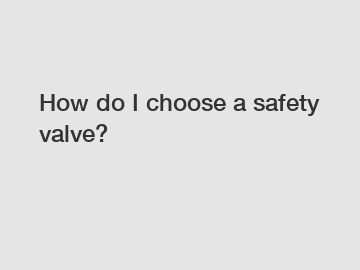How do I choose a safety valve?
When it comes to choosing a safety valve, there are a number of important factors to consider. Whether you are in the industrial, commercial, or residential sector, safety valves play a crucial role in ensuring the safety and efficiency of your operations. With so many options available on the market, it can be overwhelming to know which safety valve is the best fit for your specific needs. In this blog post, we will discuss some key factors to consider when selecting a safety valve to help you make an informed decision.
First and foremost, it is important to understand the purpose of a safety valve. A safety valve is a device designed to release excess pressure from a system in order to prevent catastrophic failure. This is especially crucial in situations where pressure can build up rapidly, such as in boilers, pressure vessels, and other high-pressure systems. By selecting the right safety valve for your application, you can ensure the safety of your equipment, personnel, and the surrounding environment.
One of the most important factors to consider when choosing a safety valve is the pressure and temperature requirements of your system. Safety valves are rated for specific pressure and temperature ranges, so it is crucial to select a valve that can handle the maximum pressure and temperature that your system may experience. Failure to do so could result in the safety valve malfunctioning when it is needed most, leading to potentially disastrous consequences.

Another key consideration when choosing a safety valve is the type of media that will be passing through the valve. Different safety valves are designed to handle different types of media, so it is important to select a valve that is compatible with the specific media in your system. For example, if you are working with corrosive chemicals or gases, you will need a safety valve that is resistant to corrosion and can withstand the chemical properties of the media.
In addition to pressure, temperature, and media compatibility, it is also important to consider the flow capacity of the safety valve. The flow capacity of a safety valve refers to the maximum amount of fluid that the valve can safely handle. This is important because if the flow capacity of the valve is too low for your system, it may not be able to release enough pressure to prevent a catastrophic failure. On the other hand, if the flow capacity is too high, it may result in the valve opening too frequently, leading to premature wear and reduced efficiency.
When selecting a safety valve, it is also important to consider the type of system in which the valve will be installed. Different systems may require different types of safety valves, such as relief valves, poppet valves, or pilot-operated valves. The specific requirements of your system will dictate the type of valve that is most suitable for your needs.
Finally, it is essential to consider the reliability and reputation of the manufacturer when choosing a safety valve. Look for manufacturers with a solid track record of producing high-quality, reliable safety valves that are trusted by industry professionals. By choosing a reputable manufacturer, you can have confidence in the quality and performance of your safety valve.
In conclusion, choosing the right safety valve is crucial for ensuring the safety and efficiency of your operations. By considering factors such as pressure, temperature, media compatibility, flow capacity, system type, and manufacturer reputation, you can select a safety valve that meets your specific needs and provides reliable protection for your equipment and personnel. Remember, safety should always be the top priority when it comes to selecting a safety valve, so take the time to research and choose wisely.
For more surface safety valves, peek o rings, peek gasketinformation, please contact us. We will provide professional answers.


